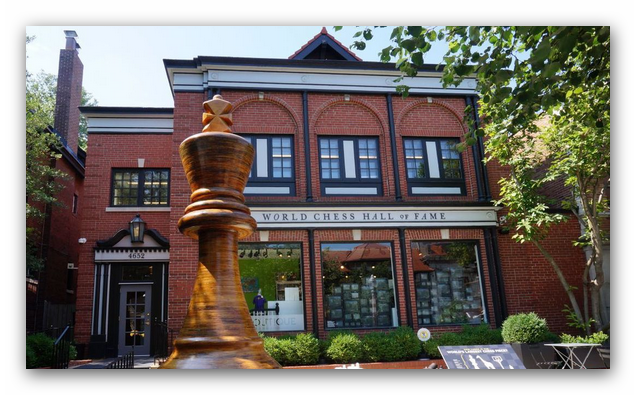Sep 29 2016 - Mar 12 2017
St. Louis, MO
On December 12, 1944, The Imagery of Chess opened at the Julien Levy Gallery in New York City on the 4th floor of a townhouse at 42 East 57th Street. Conceived by the Dadaist and chess master Marcel Duchamp, gallery owner Julien Levy, and Dadaist and Surrealist Max Ernst, the exhibition brought together a group of artists who were challenged with designing chessmen that differed from the traditional and formal Staunton and “French” sets used in everyday chess and tournament play.
Tasked with creating new “figures, at once more harmonious and more agreeable to the touch and to the sight,” over 30 artists, many of whom had previously exhibited with Levy, participated in the project, creating a variety of boards and sets as well as sculpture, music, paintings, and drawings. Though a few of the participating artists—Alexander Calder, Man Ray, André Breton, and the organizers were well known at the time, others such as Matta, Arshile Gorky, Robert Motherwell, and John Cage would emerge as significant figures in the second half of the 20th century.
Coinciding with the height of World War II, this playful and whimsical exhibition was celebrated at the time and received great press coverage in both mainstream media (Newsweek, Town & Country), and art and chess journals (Art Digest and Chess Review) among other publications. Strangely, the details of the show were not documented thoroughly and the exhibition had been widely ignored among art historians. No checklist was recorded, or has been found, so there is much speculation as to what each artist contributed to the show. Thanks to the work of independent curator, artist, and scholar, Larry List, working as the first guest curator at The Isamu Noguchi Foundation and Garden Museum, New York, in 2005 the exhibition The Imagery of Chess Revisited was organized and an accompanying catalog published. Upon reviewing archival images, Levy’s gallery ledger, and press images, List and a network of cooperative institutions, artists, estates, and private individuals reconstructed much of the original exhibition. Bringing together many of the actual works of art and reconstructing many of the “lost” pieces, the exhibition gave new life to a forgotten unique collaboration and conflation of art and chess.
World Chess Hall of Fame (WCHOF) is honored to celebrate the history of The Imagery of Chess and its impact on future artists and our own institution.The inspiration to do this comes directly from the 1944 exhibition, and more specifically, the chess-related art created by Marcel Duchamp.
Exhibition overview from museum website
Whether you go or not, The Imagery of Chess Revisited -- the catalog of the 2005 exhibition -- recovers a celebrated and extraordinary moment in art history: the 1944-45 exhibition The Imagery of Chess, held at the Julien Levy Gallery in New York City. The exhibit was a legend in its own time and has been considered a singular event in the history of art exhibitions ever since. The show's organizers—the influential art dealer Julien Levy, the Surrealist painter Max Ernst, and Dada leader Marcel Duchamp, himself a serious chess player—invited a virtual "who's who" of artists and members of the cultural avant-garde to redesign the standard chess set or otherwise explore chess imagery and its symbolism in bold new ways. Participants included famous European expatriates and soon-to-be famous American modernists: André Breton, Duchamp, Alexander Calder, Ernst, Man Ray, Isamu Noguchi, and Yves Tanguy are among those who contributed chess sets; John Cage and Vittorio Rieti created original musical scores; and Dorothea Tanning, Arshile Gorky, David Hare, Man Ray, Matta, Robert Motherwell, and others produced pivotal chess-related paintings, sculptures, and photographic works.
Featuring color photographs as well as rarely seen archival images, recollections by participants and their descendants, and period reviews, The Imagery of Chess Revisited includes previously unpublished works. Among them are André Breton and Nicolas Calas's wine-glass chess set and Alexander Calder's chess set made of found materials, in addition to thirty-five of Calder's chess-related drawings. An essay by Larry List explores the chess designs as visual objects and pivotal creations in the context of participating artists' lives and work. Lowell Cross and Paul B. Franklin examine the two musical scores included in the show; and Ingrid Schaffner provides an introduction to the art-world milieu in which The Imagery of Chess took place. 50 illustrations in color, 80 in black and white.
Exhibition Venues & Dates
Sep 29 2016 - Mar 12 2017
St. Louis, MO

